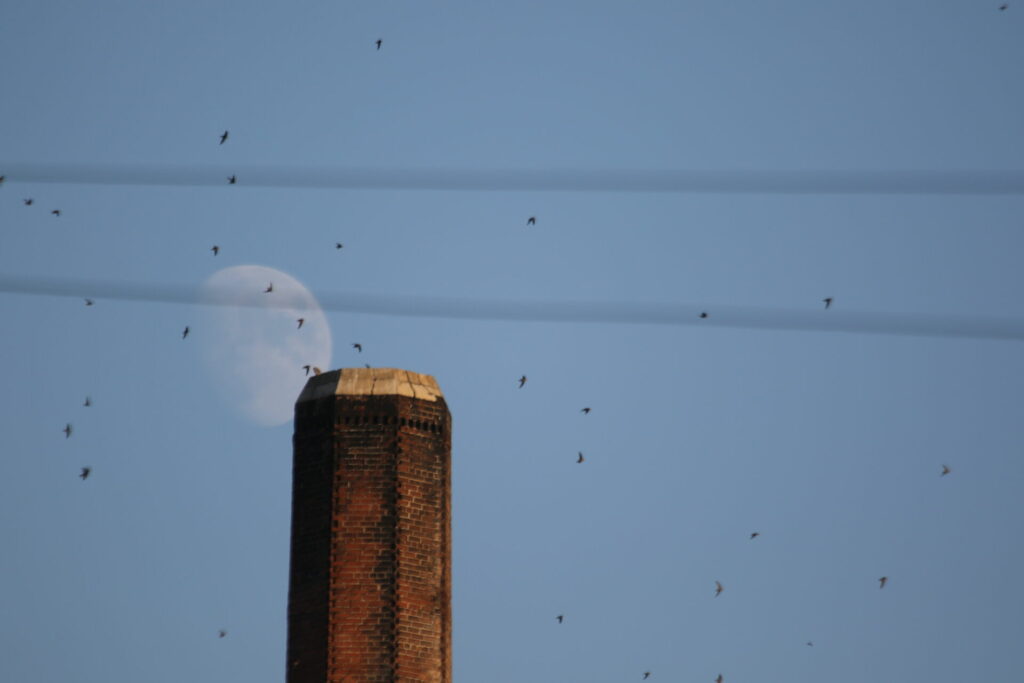Chaetura Swifts: From trees to chimneys
By Rusty Scalf
Even a passing acquaintance with the natural world reveals that species exist on a continuum from Specialist to Generalist—from species that require a very particular habitat to those that can survive in a variety of places. Both have their strengths but the vulnerabilities of the specialist are easily seen. What happens to the specialist when their special habitat is impacted? Obviously, it becomes “adapt or perish.”
Vaux’s Swifts (Chaetura vauxi) and Chimney Swifts (Chaetura pelagica)—both of which evolved to rely on hollow trees for nesting and roosting—are a case in point. What happens when humans destroy old growth forests and remove hollow trees and snags? These swifts have adapted to a different vertical, tubular structure, the chimney: residential chimneys for nesting, and large, pre-World War II industrial chimneys for migratory roosting. Why pre-World War II? Because the older chimneys are often made of concrete or brick with rough inner walls where birds can grasp and hang, while modern industrial chimneys are either metal or ceramic lined. So the chimneys used by swifts are antique, with all the scarcity and fragility this implies.

Here in the Bay Area, Vaux’s Swifts have been using the tall chimneys at McNear Brickyard in San Rafael as a staging site during fall migration for many years; possibly since these were decommissioned in 1962. Conversion from trees to human structures happened in a dramatic and complete way for the eastern Chimney Swift well more than a century ago. Now the western Vaux’s Swift is undergoing that same process.
The switch seems complete for migratory roost sites—so complete that the birds appear to be imprinted* on these big chimneys for migratory staging. Meanwhile, the conversion is well under way for nesting as well. Pacific Northwest towns commonly see Vaux’s Swifts nesting in chimneys. Here, at the extreme southern end of their breeding range, residential chimney nesting is happening in places like Sebastopol, Santa Rosa, and Napa Valley.
Chimney entry during mid-September peak migration is a sight difficult to describe. It’s just incredible to see thousands of birds pouring into a 100-foot-tall chimney, sometimes at rates of 10 to 15 per second. It’s equally amazing to witness their extensive aerial displays, or murmurations, prior to going in. These displays can last half an hour near sunset. They end when some unknown trigger causes birds to begin pouring into the chimney, often after several apparent “feints” or false starts.
Why? Why are the birds hyper-gregarious when going to roost? Why do they seem to think and function “as one”? What governs flocking behavior of an intensity that rivals anchovies in Monterey Bay, and what triggers a sudden break from the swirling and a cascade into the chimney? One can only speculate. My speculation is that we are seeing the magnification of an existing specialized behavior.
How would young birds, hatched during the past spring, know what to do or where exactly to go? In pre-Columbian times, hollow trees must have fallen and forced birds to locate replacements. There must be some process of shared and communicated knowledge. When the landscape had many old-growth snags, this process of leading and communicating must have repeated itself with smaller groups over and over again. Are we now seeing this small-group behavior magnified commensurate with the current size of their roosts? With the size of roosting flocks? Is “signaling” behavior that evolved at a much smaller scale now writ large as the roost sites enlarge beyond anything in prehistory?

This past migration was monitored by a core of four people with help from a couple of others. We tried to document its full length which, alas, at this writing continues though with very few birds. Migration spans about nine weeks from mid-August through the 3rd week in October. This year we missed just two evenings. Nightly results are reported to a biologist in Issaquah, WA who has volunteers in about 20 locations. You can see these reports at https://www.vauxhappening.org/
Migration 2021 took a similar shape to previous years with the exception of really huge numbers in late September, a lot like 2018. It was larger than the previous two seasons and much larger than 2020. Smoke from wildfires has been a real wild card. We have lost the context of monitoring at Rio Lindo Academy near Healdsburg due to Covid-19 and retirements of school staff. Rio Lindo Academy has the only other known migratory roost in northern California and we hope it will once again be monitored.
*Editor’s Note: Imprinting is the biological term for the impact of early stimuli (environment) on heredity, subsequently producing an instinctual behavior from a particular organism.
